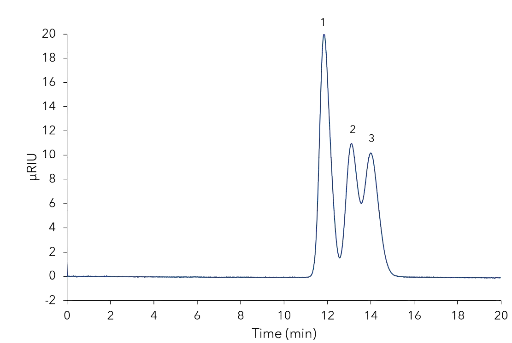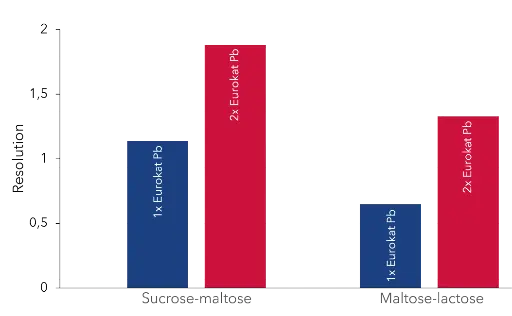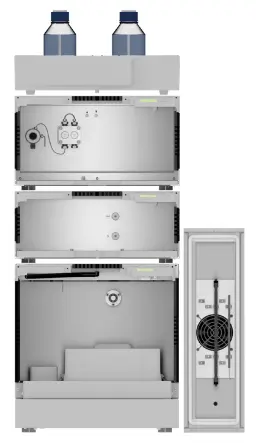
Science with Passion
Application No.: VFD0187 Version 1 12/2020
Eurokat column coupling for carbohydrate analysis
Juliane Böttcher, Kate Monks; applications@knauer.net
KNAUER Wissenschaftliche Geräte GmbH, Hegauer Weg 38, 14163 Berlin

Foto: pexels; Suzy Hazelwood (2523650)
Summary
Based on a sulfonated cross-linked styrene divinylbenzene copolymer, the ionic forms Pb and Ca are best suited for the analysis of small carbohydrates up to DP 4. No organic solvents are needed what makes these columns an excellent choice for food applications [1].
Introduction
Carbohydrate analysis is a challenging topic due to the different possible modes, columns, and detection techniques. The easiest and most robust method is an isocratic analysis combined with refractive index detection using polymer-based columns. Although, the total analysis time is often longer with polymer-based columns, they stand out with excellent pH stability and longevity as well as good results for peak resolution. The Eurokat columns combine two different separation mechanisms: size exclusion and ligand exchange. When it comes to critical peak pairs, it is easily possible to couple Eurokat columns in sequence to extend the separation range. This was applied to separate a complex mixture of six carbohydrates in just one run.
Results
The first experiments were carried out using only one of the Eurokat Pb columns with a dimension of 300 x 8 mm ID. A mixed standard of sucrose, maltose, and lactose was injected as sample (Fig. 1).

Fig. 1 Mixed standard on one Eurokat Pb column. 1 - sucrose, 2 - maltose, 3 - lactose.
As depicted, maltose and lactose are poorly separated. A qualitative identification is possible, but no useful quantification can be carried out. Therefore, to enhance the resolution of maltose and lactose, a second Eurokat column of the same dimensions and ionic form was coupled in sequence, creating a column tandem. The column coupling significantly improves the resolution between maltose and lactose (Fig. 2).

Fig. 2 Mixed standard on two Eurokat Pb columns. 1 - sucrose, 2 - maltose, 3 - lactose.
Also, in comparison the resolution improves in general for all neighboring peaks (Fig. 3).

Fig. 3 Comparison of the resolution.
Furthermore, three more analytes were added for a second mixed standard of finally six carbohydrates, which was measured with the Eurokat Pb column tandem as well (Fig. 4).

Mixed standard on column coupling Eurokat Pb (2x). 1 - sucrose,
2 - maltose, 3 - lactose, 4 - glucose, 5 - galactose, 6 - fructose.
Sample Preparations
All standards were dissolved in deionized water. The concentration of the single standards lay in a range of
Conclusion
Maltose and lactose were poorly separated using only one column. Due to the extension of the separation range with the coupling of two Eurokat Pb columns the total run time was prolonged, but it was possible to nearly achieve baseline separation of these two analytes. The addition of glucose decreases the general results for resolution, but the separation is still sufficient to clearly quantify all six analytes.
Materials and Methods
Tab. 1 Method
Column temperature | 75 °C |
Injection volume | 10-20 µl |
Injection mode | Partial loop |
Detection | RID |
Data rate | 20 Hz |
Time constant | 0.05 s |
Tab. 2 Pump program
Eluent (A) | Water |
Flow rate | 0.5 ml/min |
Gradient | Isocratic |
Tab. 3 System configuration
Instrument | Description | Article No. |
Pump | AZURA P6.1L, isocratic | |
Autosampler | AZURA AS 6.1L | |
Detector | AZURA RID 2.1L | |
Thermostat | AZURA CT 2.1 | |
Column | 2 x Eurokat Pb, 300 x 8 mm ID | |
Software | ClarityChrom 8.2.3 – workstation, autosampler control included |
References
KNAUER Wissenschaftliche Geräte. https://www.knauer.net/columns-hplc-of-sugars-organic-acids-alcohols.
Related KNAUER applications
VFD0169 - Determination of sugars in honey - comparison of refractive index and light scattering detection
VFD0184 - Everything solved – Carbohydrate content in instant coffee with PAD
Application details
|
Method |
HPLC |
|
Mode |
Ion exclusion, Ligand exchange, RP |
|
Substances |
sucrose, maltose, lactose, glucose, galactose, fructose |
|
CAS number |
57-50-1 , 69-79-4, 63-42-3 , 58367-01-4, 59-23-4, 6035-50-3 |
|
Version |
Application No.: VFD0187 | Version 1 12/2020 | ©KNAUER Wissenschaftliche Geräte GmbH |



